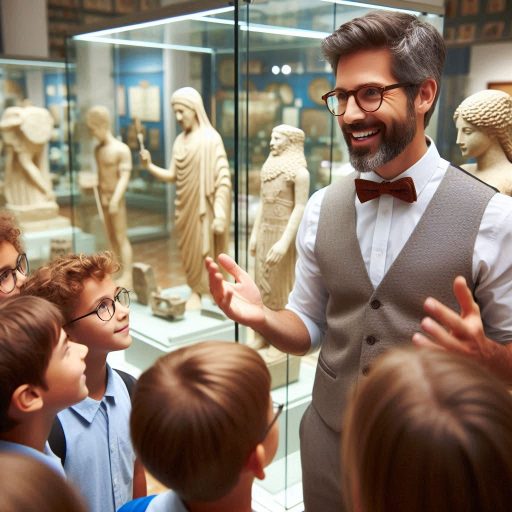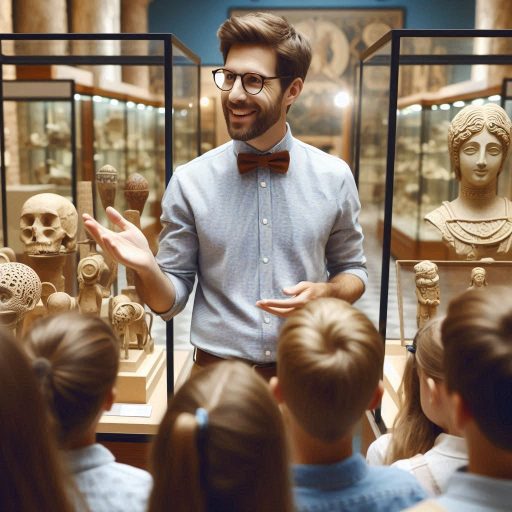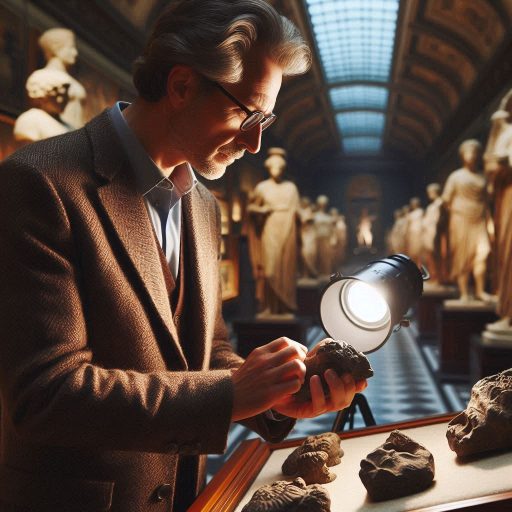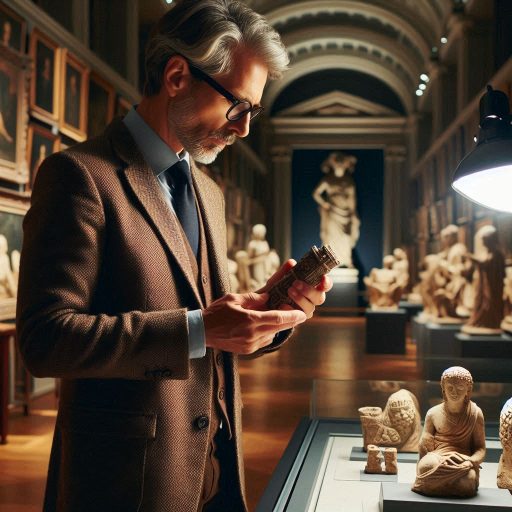Introduction
A museum curator plays a vital role in preserving and presenting art.
They manage collections, organize exhibitions, and engage with the public.
Curators conduct research, interpret artworks, and ensure that pieces are displayed in meaningful ways.
Their expertise helps connect visitors with art, history, and culture.
Art conservation is a critical aspect of a curator’s responsibilities.
It involves the protection and preservation of artworks for future generations.
As custodians of cultural heritage, curators prioritize maintaining the integrity and longevity of their collections.
This work is essential in safeguarding our shared history, as many artworks face deterioration due to age, environmental factors, and misuse.
In the museum setting, art conservation goes beyond simple preservation.
It ensures that every piece remains accessible, allowing visitors to experience and learn from art.
Effective conservation practices enhance the educational mission of museums, making art relevant and engaging.
Understanding the importance of art conservation highlights the curator’s role in not only maintaining artifacts but also enriching the cultural landscape for all.
Responsibilities of a Museum Curator
Acquisition of Artwork for the Museum’s Collection
Museum curators hold critical responsibilities that shape the institution’s mission.
They acquire artwork for the museum’s collection, ensuring it aligns with the institution’s vision.
This acquisition process often involves negotiations with artists, galleries, and collectors.
Curators must evaluate artworks’ historical significance, cultural relevance, and authenticity before making decisions.
They aim to build a diverse collection that represents various cultures and time periods.
Researching and Interpreting Artwork for Exhibitions
Researching and interpreting artwork is another vital responsibility for curators.
They conduct in-depth studies to understand each piece’s context and significance.
This research informs how they present the artwork to the public.
Curators write exhibition texts, labels, and catalog entries that enhance visitor understanding.
They also create educational materials to engage audiences and deepen their appreciation for the art.
Collaborating with Conservation Specialists for the Preservation of Artwork
Collaboration with conservation specialists is essential for preserving artwork in a museum’s collection.
Curators work closely with conservators to assess the condition of each piece.
Together, they develop preservation strategies that prevent deterioration and damage.
Curators must understand conservation principles to make informed decisions about display and storage conditions.
This knowledge helps protect artworks from environmental factors such as light, humidity, and temperature.
When planning exhibitions, curators consider how to best showcase the artwork while ensuring its safety.
They collaborate with conservators to determine optimal display methods and materials.
This partnership ensures that artwork remains accessible to the public while safeguarding its integrity.
Curators also develop exhibition layouts that enhance the viewing experience.
They carefully consider sightlines, lighting, and spacing to create a cohesive narrative.
Additionally, curators play a key role in educating the public about conservation practices.
They organize programs and workshops that highlight the importance of preserving cultural heritage.
Through these initiatives, curators promote awareness of the challenges faced in art conservation.
They engage audiences in discussions about the ethics and responsibilities of preserving artworks.
Curators also stay informed about advancements in conservation techniques and materials.
They attend conferences, workshops, and seminars to learn from experts in the field.
This continuous education allows them to implement best practices in their museums.
By staying current, curators enhance their ability to protect and conserve their collections.
Museum curators are responsible for acquiring, researching, and interpreting artwork.
Their collaboration with conservation specialists ensures the preservation of cultural heritage.
Through their efforts, curators enhance public understanding and appreciation of art.
They play a vital role in safeguarding our artistic legacy for future generations.
Read: Top Skills Needed for a Successful Character Designer
The Importance of Art Conservation
Preserving Cultural Heritage for Future Generations
Art conservation plays a crucial role in preserving cultural heritage for future generations.
Each artwork represents a unique narrative that reflects societal values, beliefs, and creativity.
By conserving these pieces, we ensure that future audiences can appreciate their historical significance and context.
This preservation allows subsequent generations to connect with their cultural roots, fostering a deeper understanding of their history and identity.
It also enables the sharing of diverse cultural narratives, promoting inclusivity and respect for different perspectives.
Preventing Deterioration of Artwork Due to Environmental Factors
Preventing the deterioration of artwork due to environmental factors is one of the main goals of art conservation.
Light, humidity, temperature, and pollutants can significantly damage artworks.
For example, excessive light exposure can cause colors to fade, while high humidity can lead to mold growth.
Conservators carefully monitor these conditions in museum environments.
They implement measures to control lighting, humidity levels, and temperature fluctuations.
By using specialized storage and display materials, conservators protect artworks from fading, warping, or degrading over time.
These precautions are vital in maintaining the artwork’s physical integrity and aesthetic quality.
Ensuring the Longevity and Integrity of the Museum’s Collection
Ensuring the longevity and integrity of a museum’s collection is a primary concern for curators and conservators.
Each piece of art carries unique cultural value and reflects the vision of its creator.
Proper conservation techniques help maintain these works’ physical and aesthetic qualities.
This commitment to preservation ensures that artworks remain intact for public viewing and education.
Moreover, well-preserved collections enhance the museum’s reputation and attract more visitors.
Art conservation also contributes to the overall health of the museum’s collection.
Museums that prioritize conservation demonstrate their commitment to cultural stewardship.
This dedication fosters trust and respect within the community and among stakeholders.
Visitors often feel more connected to museums that show a genuine commitment to preserving cultural heritage.
They appreciate the efforts made to maintain the integrity of the artworks.
Additionally, conservation facilitates research opportunities within the art world.
Scholars can study preserved artworks to gain insights into artistic techniques, materials, and historical context.
This research often leads to new discoveries that enhance our understanding of art history.
Consequently, conservation efforts have far-reaching implications that extend beyond the museum walls, benefiting scholars, artists, and the public alike.
Art conservation is vital for preserving cultural heritage, preventing deterioration, and ensuring the integrity of collections.
It enables future generations to engage with and appreciate the rich tapestry of human creativity.
By investing in art conservation, museums uphold their responsibility to protect and share our cultural legacy.
This commitment enriches our understanding of the past and inspires future creativity.
Read: Career Paths in Ceramic Art and Design
Role of a Museum Curator in Art Conservation
Supervising the Handling and Display of Artwork
Museum curators play a critical role in supervising the handling and display of artwork.
They ensure that each piece receives proper care and attention.
Curators develop guidelines for safely moving and installing artworks.
These guidelines prevent damage during transportation and display.
Curators also train staff on best practices for handling fragile pieces.
Their expertise ensures that all artworks are treated with respect and caution.
Additionally, curators design exhibitions with conservation in mind.
They consider factors such as lighting, temperature, and humidity levels when planning displays.
Curators choose appropriate materials for framing and mounting artworks.
By making informed decisions, they create a safe environment for the collection.
This careful planning protects the artworks from environmental stressors that could cause deterioration.
Implementing Conservation Techniques to Prevent Damage
Implementing conservation techniques to prevent damage is another essential responsibility of museum curators.
They stay informed about the latest conservation methods and practices.
This knowledge allows them to apply effective techniques to safeguard the collection.
Curators work closely with conservation specialists to develop and implement these strategies.
For example, curators might decide to use acid-free materials for storage and display.
These materials help prevent chemical reactions that can harm artworks over time.
They may also establish regular maintenance schedules for monitoring the condition of artworks.
By conducting routine checks, curators can identify potential issues early and address them promptly.
Curators also advocate for preventive conservation measures within the institution.
They educate staff and visitors about the importance of proper care for artworks.
This outreach fosters a culture of conservation that extends beyond the museum’s walls.
Curators emphasize the significance of preserving art for future generations, inspiring others to value and protect cultural heritage.
Collaborating with Conservation Scientists to Conduct Research on Preservation Methods
Collaborating with conservation scientists is a vital aspect of a curator’s role in art conservation.
Curators often work alongside scientists to conduct research on preservation methods.
This collaboration ensures that curatorial decisions are based on scientific principles and findings.
Together, they analyze the materials used in artworks and assess their condition.
By engaging in this research, curators can identify the best practices for conserving different types of art.
They learn how various environmental factors affect artwork longevity.
This knowledge enables curators to make informed decisions about storage and display practices.
Moreover, collaboration with conservation scientists often leads to innovative preservation solutions.
Curators can implement new technologies and methods to enhance conservation efforts.
This teamwork ultimately benefits the museum, its collection, and its visitors.
By prioritizing collaboration, curators reinforce their commitment to preserving art for future generations.
Read: Freelance Character Design: How to Get Started

Case Studies of Successful Art Conservation Projects
Specific Artwork That Required Conservation Efforts
Art conservation projects often revolve around specific pieces that require careful restoration.
One notable example is “The Night Watch” by Rembrandt.
This iconic painting, housed in the Rijksmuseum, suffered significant damage over the centuries.
Over time, layers of dirt and previous restorations obscured its vibrant colors and details.
The painting required a comprehensive conservation effort to restore its original beauty.
Another remarkable case is “The Great Wave off Kanagawa” by Hokusai.
This woodblock print faced deterioration due to environmental factors and improper handling.
It needed urgent conservation measures to preserve its intricate details and colors.
Each of these artworks represents the challenges and complexities involved in the conservation process.
Challenges Faced and the Strategies Used to Restore the Artwork
Conserving “The Night Watch” presented numerous challenges.
The primary issues included the painting’s large size and the layers of varnish that altered its appearance.
Conservators needed to develop a meticulous plan.
They employed advanced imaging techniques to analyze the layers of the painting.
This approach helped them identify the original colors and details that were hidden beneath the surface.
In contrast, “The Great Wave off Kanagawa” faced challenges related to paper deterioration.
The print had tears, creases, and fading colors.
Conservators used a combination of wet and dry cleaning techniques to remove dirt and grime.
They also applied specialized treatments to strengthen the paper.
By carefully reassembling torn areas, they restored the print’s integrity and visual impact.
Both projects illustrate the importance of using appropriate techniques and materials in art conservation.
Collaboration between conservators, curators, and scientists is essential for addressing specific challenges.
These efforts ensure that artworks are preserved for future generations.
Before and After Images of the Conservation Process
The transformation of artworks during conservation efforts is often striking.
For instance, before and after images of “The Night Watch” reveal the incredible impact of the restoration process.
The before image showcases a darkened painting, with much of the original detail obscured.
In contrast, the after image displays a vibrant and detailed composition that captures Rembrandt’s masterful technique.
Similarly, the before and after images of “The Great Wave off Kanagawa” highlight the effectiveness of conservation efforts.
The before image shows fading colors and visible damage, while the after image presents a revitalized print, with brilliant colors and sharp details.
These visual comparisons demonstrate the transformative power of conservation.
Successful art conservation projects exemplify the dedication and expertise of conservators.
These projects not only restore artworks but also allow future generations to engage with and learn from our artistic legacy.
Read: Career Paths: Becoming a Professional Character Designer
Training and Qualifications for Museum Curators in Art Conservation
Educational Background in Art History, Museum Studies, or Conservation
Museum curators in art conservation typically possess a strong educational background.
Most hold advanced degrees in art history, museum studies, or conservation.
These programs provide foundational knowledge about art, history, and preservation techniques.
Students learn about various art forms, styles, and cultural contexts.
They also study the science behind art conservation, including materials and degradation processes.
Many programs offer specialized courses focused on conservation methods.
This coursework covers topics such as preventive care, restoration techniques, and ethical considerations in conservation.
Graduates emerge with a comprehensive understanding of both the artistic and scientific aspects of their field.
This strong educational foundation is crucial for effective art conservation and curation.
Hands-on Experience Through Internships or Apprenticeships
Hands-on experience is essential for aspiring museum curators.
Many pursue internships or apprenticeships during or after their formal education.
These opportunities provide practical exposure to the day-to-day operations of museums and conservation departments.
Interns often assist with various tasks, such as preparing artworks for exhibitions or participating in conservation treatments.
Internships allow future curators to learn from experienced professionals.
They gain insight into the challenges and intricacies of art conservation.
This practical training helps interns develop essential skills and build valuable networks within the museum community.
Such experience is vital for securing permanent positions in the competitive field of art conservation.
Continuous Professional Development to Stay Updated on Conservation Techniques
The field of art conservation is constantly evolving.
Therefore, continuous professional development is crucial for museum curators.
They must stay updated on the latest conservation techniques and advancements in technology.
Many curators attend workshops, conferences, and seminars to enhance their knowledge and skills.
Professional organizations, such as the American Institute for Conservation (AIC), offer resources for ongoing education.
These organizations provide access to publications, webinars, and networking opportunities.
By participating in these activities, curators can learn about new materials, tools, and methods for art conservation.
Additionally, curators often engage in collaborative research projects.
Working alongside scientists and conservation specialists allows them to explore innovative approaches.
This collaboration fosters a culture of learning and adaptation in the museum field.
The training and qualifications for museum curators in art conservation are multifaceted.
A solid educational background, hands-on experience, and ongoing professional development are essential.
These components equip curators with the knowledge and skills necessary to protect and preserve artworks for future generations.
The commitment to lifelong learning enhances their effectiveness in the crucial role of art conservation.
Transform Your Career Today
Unlock a personalized career strategy that drives real results. Get tailored advice and a roadmap designed just for you.
Start NowEthical Considerations in Art Conservation
Balancing Preservation Goals with the Original Intent of the Artist
Museum curators face significant ethical challenges in art conservation.
One primary concern is balancing preservation goals with the original intent of the artist.
Curators strive to maintain the artwork’s integrity while also ensuring its longevity.
This requires deep understanding and sensitivity to the artist’s vision.
When making conservation decisions, curators must consider how interventions affect the original work.
They often debate whether to restore or leave certain elements as they are.
Striking this balance can be complex, as it involves understanding both technical aspects and artistic intent.
To honor the artist’s vision, curators frequently consult art historians and experts.
This collaboration ensures that conservation efforts respect the original style and materials used in the artwork.
Ultimately, curators must carefully navigate these choices to protect both the artwork and its legacy.
Respecting the Cultural Significance of Artwork When Implementing Conservation Treatments
Another critical ethical consideration is respecting the cultural significance of artwork.
Many pieces hold deep cultural meaning for specific communities.
Curators must recognize this context when implementing conservation treatments.
Consulting with community stakeholders is essential in these cases.
Engaging with cultural representatives helps curators understand the artwork’s significance.
This collaboration ensures that conservation efforts honor the traditions and narratives associated with the piece.
By involving the community, curators can make informed decisions that respect cultural heritage.
This approach fosters trust and acknowledges the artwork’s role in the community’s identity.
Ethical art conservation should always include cultural sensitivity and awareness.
Ensuring Transparency and Accountability in the Conservation Process
Transparency and accountability are vital in the conservation process.
Curators must clearly document every step of their conservation efforts.
This documentation includes detailing the materials used and the rationale behind each decision.
Such transparency is crucial for future reference and public trust.
It allows others to understand the methods and choices made during conservation.
Museums often publish conservation reports to share their practices with the public.
Accountability also extends to seeking peer review and input from experts in the field.
Collaborating with other conservators ensures best practices are followed.
This commitment to ethical standards helps maintain the integrity of the conservation profession.
Ethical considerations in art conservation are multi-faceted.
Curators must balance preservation goals with the artist’s intent while respecting cultural significance.
Ensuring transparency and accountability further enhances the credibility of the conservation process.
By navigating these ethical challenges, curators play a critical role in preserving our shared cultural heritage.
Technological Advances in Art Conservation
Utilization of Digital Imaging Techniques for Documentation and Analysis
Digital imaging techniques revolutionize art conservation.
Curators now use high-resolution imaging to document and analyze artwork.
These images capture intricate details that the naked eye might miss.
Techniques like infrared reflectography and ultraviolet fluorescence reveal underlayers and hidden features of the artwork.
Such detailed documentation helps in understanding an artwork’s history and condition.
Curators can compare past and present images to track changes over time.
This information guides conservation strategies, ensuring more effective preservation.
Non-Invasive Methods for Examining Artwork Without Causing Damage
Non-invasive methods play a critical role in art conservation.
Techniques like X-ray fluorescence (XRF) allow curators to analyze materials without damaging the artwork.
These methods provide insights into the composition and condition of the piece.
Curators can identify pigments, binders, and other materials used by the artist.
This information is crucial for planning conservation treatments.
By avoiding invasive procedures, curators preserve the artwork’s integrity while gaining valuable knowledge about its composition and history.
3D Printing Technology for Creating Replicas of Fragile Artifacts for Display
3D printing technology offers innovative solutions for displaying fragile artifacts.
Curators can create replicas that closely mimic the original pieces.
This allows museums to showcase artworks without risking damage to the originals.
These replicas can be made from various materials, providing realistic textures and colors.
Curators often use 3D printing for educational purposes, allowing visitors to interact with the replicas.
This technology enhances accessibility while preserving the integrity of the original artwork.
By utilizing 3D printing, curators ensure that delicate pieces remain protected while still engaging audiences.
Technological advances significantly impact art conservation practices.
From digital imaging to non-invasive analysis methods, these innovations enhance curators’ ability to preserve artworks.
Additionally, 3D printing technology allows for safe display of fragile artifacts.
These advancements not only protect our cultural heritage but also enrich the visitor experience, ensuring that art remains accessible for future generations.
Conclusion
Museum curators play a crucial role in art conservation.
Their responsibilities extend beyond managing collections; they ensure the longevity and integrity of artworks.
By advocating for preservation, curators help maintain our cultural heritage for future generations.
Collaboration is vital in this field.
Curators work closely with conservation specialists and scientists to implement effective strategies.
This teamwork combines expertise from different disciplines, ensuring comprehensive conservation practices.
Together, they tackle challenges and find innovative solutions to protect valuable artworks.
We encourage readers to appreciate the importance of preserving artwork.
Each piece carries a unique story and cultural significance.
Supporting the efforts of curators and conservationists helps safeguard our artistic heritage for future generations.
Understanding their work fosters a deeper connection to the art we cherish.
By valuing art conservation, we contribute to the legacy of our shared history.
Museum curators ensure that art continues to inspire and educate, enriching our cultural landscape.
Their dedication and collaboration pave the way for future generations to experience the beauty and significance of art in our world.
[E-Books for Sale]
The Big Book of 500 High-Paying Jobs in America: Unlock Your Earning Potential
$19.99 • 500 High-Paying Jobs • 330 pages
Explore 500 high-paying jobs in America and learn how to boost your career, earn more, and achieve success!
See All 500 High-Paying Jobs of this E-Book
1001 Professions Without a Degree: High-Paying American Jobs You Can Start Now
$19.99 • 1001 Professions Without a Degree • 174 pages
Discover 1001 high-paying jobs without a degree! Unlock career tips, skills, and success strategies for just $19.99!




